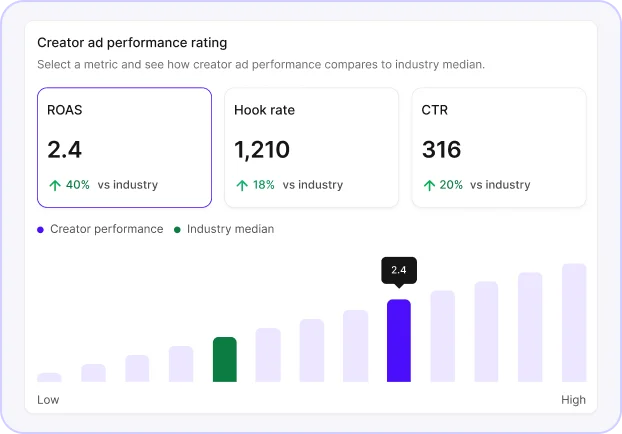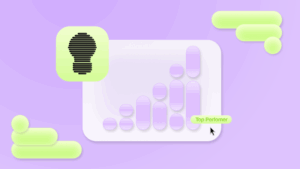Why Ad Iterations Matter: Faster Testing, Higher ROAS
Passionate content and search marketer aiming to bring great products front and center. When not hunched over my keyboard, you will find me in a city running a race, cycling or simply enjoying my life with a book in hand.

Ad creative isn’t just a nice-to-have, it’s the biggest lever for return on ad spend. Meta research shows that 56% of campaign performance is driven by creative itself, far outweighing targeting or budget optimizations.
That’s why today’s smartest marketers aren’t chasing endless new ideas – they’re iterating. Ad iterations allow brands to keep their top-performing ads fresh by making small, strategic tweaks instead of reinventing the wheel. This speeds up creative testing, improves efficiency, and drives consistent gains in ROAS. As Meta’s Performance 5 framework recommends, constant creative testing is key to cutting CPA and boosting conversions.
In this post, we’ll break down what ad iterations are, why they matter more than ever, and how to implement them with proven frameworks and AI-powered tools.
TL;DR:
- Rotate ad iterations weekly to dodge fatigue and lift ROAS.
- Test 4-6 variants, devote 10-20 % budget to experiments.
- Pause losers at 3× CPA or 50 conversions without lift.
- Track hook rate, CTR, frequency; refresh when metrics slide.
- Use AI tools to generate, analyze, and scale winning creatives.
What are Ad Iterations?
Ad iterations are small, data-driven tweaks to a winning creative. It is usually something like swapping a headline, tightening the hook, or adding a new CTA, rather than reinventing the whole concept.
Because each tweak isolates one variable, you can run systematic A/B tests that reveal real lift. There are some varying schools of thought when it comes to ad testing though. Some say that it is best to test 1 element at a time. While others prefer to launch larger creative ad sets and find ones that perform the best. Either way, tracking the performance is key – CTR, CPA, hook-rate are your best friends in such scenarios.
A quick proof point: a Ladder case study pitted a lifestyle angle against an efficiency claim for the same product. The subtle angle shift lifted CTR by 50 % in a single cycle – that’s a huge gain from one focused change. And an easy test to perform for most marketers.
Why Iterations Matter
Ad iterations keep winning creatives alive longer. When you know exactly whether you need a fresher hook, tighter body copy, or a new landing page, each tweak becomes purposeful, not random.
Fatigue sneaks in fast. A 15–20 % CTR drop across two-three weeks is the clearest red flag, warns Dancing Chicken. When you spot that slide, roll out ad iterations instead of recycling the entire concept. A quick copy swap or new opener can reset performance, no full reshoot required.
Iterative campaigns consistently beat static ones. In head-to-head tests, brands that refreshed micro-elements saw higher lift and faster optimization cycles, according to Lucid Leads. Pair those quick pivots with real-time tracking inside your ad-performance metrics dashboard to know exactly when to promote winners and pause losers.
Building a habit of bold, frequent ad iterations is the surest way to dodge creative fatigue and keep ROAS climbing.
Frameworks & Testing Methodologies

A winning ad iteration engine follows the same three-step rhythm every time: launch, measure, refine. Stick to this cadence and each cycle delivers cleaner data and faster ROAS gains.
- Build a structured test loop
- Launch 4 – 6 variants per ad set, dedicate 10 – 20 % of budget to testing, and pause any creative that hits 3× CPA without converting.
- This simple stop-loss rule, outlined in Adapty’s 2025 testing guide, funnels winners into evergreen campaigns while cutting spend on duds early.
- Split-test with platform controls
- In Google, the Ad Variations tool runs a clean 50/50 split, auto-scores significance after 7-14 days, and can auto-apply the champ once it clears the threshold (Google Ads Help, 2025).
- On Meta, budget for ≈ 50 conversions per variant so each ad exits the learning phase, anything less risks false signals (Admiral Media guide, 2024).
- Diagnose and iterate
- After each round, check thumb-stop rate, scroll depth, and hook retention.
- If a variant underperforms, pull inspiration from different angles and proven UGC hooks. Aim to swap just one detail, like the opener or CTA before the next flight.
Codifying these three steps turns ad iterations from creative guesswork into a repeatable, data-driven engine for scale.
Automate Ad Iterations with AI
With the rise of AI, creative testing can become a little easier.
1. Turn stills into scroll-stoppers
Meta’s new Advantage+ update (June 2025) converts a single product shot into multiple formats. Still-image-to-video, auto-cropping, and fresh text variants, all inside Ads Manager. That means you can spin out bold ad iterations in minutes, not days. Giving a simple way to dodge fatigue before it starts. However, there is still a question of alignment with brand values and originality.
2. Spot fatigue before performance tanks
Motion’s AI Creative Strategists cluster hooks, flag dips in thumb-stop rate, and triple weekly concept output. Use those insights alongside your ad-performance metrics dashboard to decide which ad iterations deserve extra spend and which need a quick refresh.
3. Let automation handle the split-testing grind
Advantage+ also learns which creatives and placements win – freeing humans to craft stronger narratives, not pivot spreadsheets. Pair the automation loop with lessons from our UGC marketing playbook to keep each new batch of ad iterations rooted in authentic creator stories.
Leaning on AI for rapid variation production and real-time diagnostics lets you redirect energy toward the high-impact work. Such as concepts, storytelling, and revenue-driving insights.

Key Metrics to Judge Ad Iterations
Effective testing lives or dies by numbers, not vibes. Track these three metrics every week to know when a tweak is a winner or when fatigue is creeping in.
Hook rate ≥ 30 % & Hold rate ≈ 10 %
The baseline pass/fail thresholds come from an Adapty tutorial. Anything lower means the opening seconds aren’t pulling their weight.
Action: Refresh the first three seconds – swap the hook or visual before scaling spend.
CTR lift vs. the control
In a Ladder case study, a lifestyle angle boosted CTR by 50% over an efficiency-focused variant. Giving roof one variable can deliver outsized gains.
Action: Treat a ≥ 15 % CTR improvement as your cue to move that ad iteration into your evergreen set.
Fatigue triggers: 15–20 % CTR slide or frequency > 3–4
A Dancing Chicken analysis flags these thresholds as the first signs viewers are tuning out.
Action: When either limit hits, roll out fresh ad iterations and monitor results inside your ad-performance metrics dashboard to catch the rebound.
By watching these three numbers, you can turn ad iteration from guesswork into measurable growth levers.
Common Pitfalls to Dodge
Stretch a limited budget across a dozen variants and each one starves. Search Engine Journal notes that spreading spend too thin “delays statistical significance and breeds false positives,” so you risk scaling the wrong creative. The simple fix is to cap each round at four to six ad iterations or raise the test budget until every idea gets real reach. So avoid going the guess-and-hope route.
Stopping a test early is just as dangerous. Admiral Media pegs ≈ 50 conversions per variant as the minimum for Meta to exit the learning phase; cut it short and your data is noise, not insight. Another thing to consider is that even proven winners will tank if you hammer the same viewer too often. After seven to eight exposures, CTR can drop 40%, according to WifiTalents’ 2025 ad-fatigue report.
Ensure to keep frequency below four, budget each variant to clear 50 conversions, and rotate fresh ad iterations the moment CTR slides 15-20%. Avoid these traps and every test produces clear, actionable signals – fuel for the next round of high-ROAS iterations.
Looking to create ad iterations from your existing creatives? Billo’s AI mashups give you 3 instant creatives to use in the next campaign.

Summary & Next Steps
Iterative testing isn’t a side quest – it’s the growth engine. Launch ad iterations every week, pause losers fast, and promote winners at scale. Lean on platform tools to keep the math honest, AI to crank out fresh variations, and three core metrics – hook rate, CTR, and frequency, to know exactly when fatigue sets in.
Your move: spin up a 4-6-variant test today, budget enough to hit 50 conversions per creative, and set an auto-rule to pause anything that overspends without converting. Then review results on Friday, double down on the champ, and brief the next batch. Repeat that loop and ROAS keeps climbing while creative fatigue never gets a foothold.
Looking to source your next set of ads? Explore Billo vetted creators to move fast.
FAQs
How many variants should I test at once?
Run 4-6 ad iterations per ad set and change only one element at a time. This lets you see clear winners without starving each variant of budget or impressions.
What counts as statistical significance?
Aim for 95 % confidence or roughly 50 conversions per variant. Hitting that threshold means your lift is real, not random noise.
When should I refresh creative?
Check performance weekly. If CTR slides 15-20 % or frequency climbs above 3-4, roll out fresh ad iterations before fatigue erodes ROAS.
Does AI replace human creatives?
No. AI handles the mechanics of generating and testing variations. Humans are still essential for big-picture concepts, storytelling, and brand voice.
SEO Lead
Passionate content and search marketer aiming to bring great products front and center. When not hunched over my keyboard, you will find me in a city running a race, cycling or simply enjoying my life with a book in hand.

Authentic creator videos, powered by real performance data
22,000+ brands use Billo to turn UGC into high-ROAS video ads.
Testing Ad Variations: How to Consistently Lift ...
Most performance gains come from better creative, not targeting tweaks. [...]...
Read full articleAI‑Driven Creative Coaching: How Machine Learn...
Creative is no longer just a variable – it’s the [...]...
Read full articleFrom Brief to Breakthrough: Translating Data Ins...
Marketing performance rises and falls on creative quality, but most [...]...
Read full article



